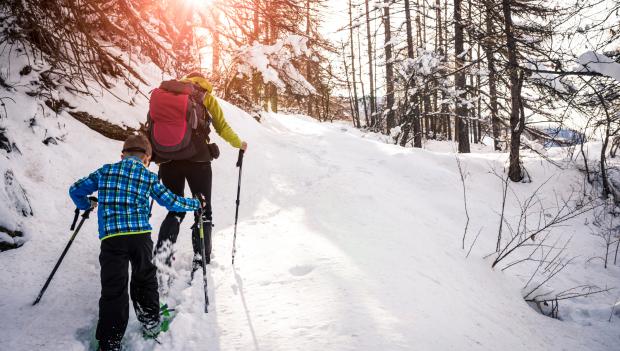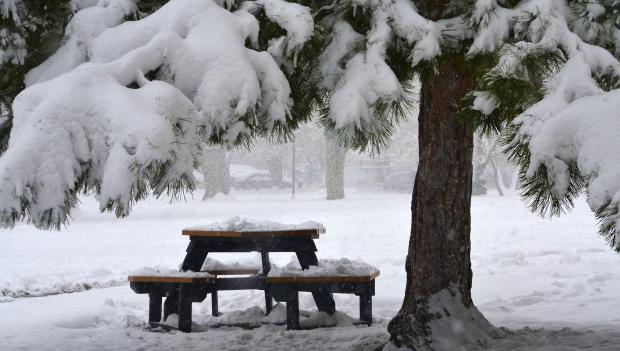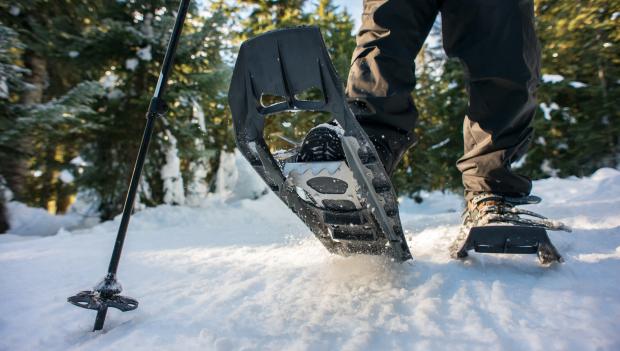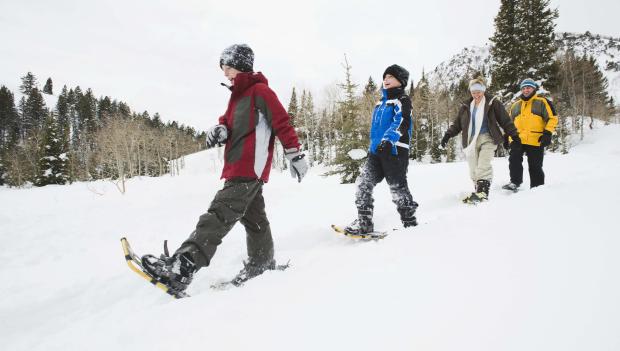The Best Places to Snowshoe

Snowshoeing is growing in popularity for being an accessible winter sport that is easy to learn. All you need are a few inches of snow, snowshoes, and a relatively flat trail. Essentially, if you can hike, you can snowshoe! Below are destinations that we rate as among the best places to snowshoe and camp, followed by snowshoeing tips for beginners.
Recommended: Crampons vs. Microspikes vs. Snowshoes - What to Use
1. Ponderosa State Park, Idaho
Why We Love It:
- Miles of relatively flat trails including a designated snowshoe trail
- Nestled amongst beautiful, 150-foot tall ponderosa pine
- Great wildlife spotting opportunities
Named for the famed 150-foot-tall ponderosa pine in the area, Ponderosa State Park is a biologically diverse area, replete with forests of grand fir, douglas fir, lodgepole pine, and western larch along Payette Lake. Over 12 miles of groomed trails bisect the park, in addition to a designated snowshoe trail. While snowshoeing, you might spy wildlife like deer, moose, beaver, Canadian geese, bald eagles, osprey, wood ducks, and mallards. The campground has over 100 campsites, 23 of which are companion sites that accommodate two trailers or camping rigs, as well as camper cabins.

2. Pilot Knob State Park, Iowa
Why We Love It:
- Beautiful historical structures set in picturesque countryside
- 14 miles of snowshoeing and hiking trails
- Lake in the park where you can also ice skate or ice fish
This park is beloved for its combination of natural attractions and historical structures. In the 1930s, the Civilian Conservation Corps built several structures now recognized by the National Register of Historic Places, including the entrance portals, shelters, stone bridges, amphitheater, and observation tower. The structures are set in an area with nearly 14 miles of trails traversing a bird-filled forest along the banks of 15-acre Dead Man's Lake. Besides snowshoeing through a picturesque forest, park visitors can also ice skate on the lake or try their hand at ice fishing. For campers, there are 65 sites available, including electric and full hookup.

Recommended: 5 Great Places to Ice Fish This Year
3. Codorus State Park, Pennsylvania
Why We Love It:
- Large park with rolling hills perfect for snowshoeing
- Over 19 miles of snowshoeing and hiking trails
- Yurts and cottages available to rent
Nestled in the rolling hills of southern York County, Codorus State Park is a large, 3,490-acre nature preserve perfect for snowshoeing. It boasts over 19 miles of designated hiking trails, including portions alongside Lake Marburg. Beginners may want to try Mary Ann Furnace Trail, an easy 3.8-mile loop suitable for the whole family to snowshoe. There are nearly 200 campsites available, including electric hookups, as well as two yurts and three cottages.

4. La Pine State Park, Oregon
Why We Love It:
- Miles of trails within the park and adjacent to the park
- Set in a picturesque high desert subalpine forest
- Close to national parks with advanced snowshoeing opportunities
LaPine State Park rests in a scenic spot along the Upper Deschutes River in a high desert subalpine forest. The quiet, shady campground connects to 14 miles of multi-use trails that snowshoers can follow to key park landmarks. LaPine is also centrally situated for exploring the iconic landmarks of central Oregon, including the Deschutes National Forest, Newberry Crater, and Lava River Cave, which allow access to many more miles of snowshoeing trails. Additionally, Crater Lake National Park is just over an hour’s drive away. This famed winter wonderland gets a whopping 43 feet of snow in the winter. This means plenty of snowshoeing opportunities, including guided ranger snowshoe walks.

5. Wasatch Mountain State Park, Utah
Why We Love It:
- The 2002 Winter Olympic Games were held here
- Good for all snowshoe levels, from entry-level guided hikes to backcountry exploration
- Plenty of camping sites, including those with full hookups and cabins
Located in Heber Valley at the site of the 2002 Olympic Winter Games, Wasatch Mountain State Park is a winter sport enthusiast’s paradise. There is plenty of wilderness area to explore for all levels of snowshoers. Immerse yourself in the backcountry, or try a guided snowshoe hike based out of the Wasatch Mountain State Park Visitor’s Center. The park has 125 camping spots available, including sites with full hookups and cabins.

Recommended: Hiking in the Snow-What You Need to Know
Getting the Right Snowshoeing Gear
Clothing
When confronting wintry weather while snowshoeing, be sure to layer your clothing. This means a base layer made of polyester or wool, and never cotton. Top your base later with a mid-layer, like fleece or down jackets. Your outer layer, including jacket and pants, should be waterproof. Don’t forget your warm hat, wool socks, waterproof gloves, and sturdy, weatherproof boots!
Snowshoe Poles
You’ll want to bring a set of snowshoe poles, or regular trekking poles with a basket for the snow. A set of poles will not only help with balance but be your best friend in feeling out and avoiding snowdrifts.
Snowshoes
If you are just trying out the sport, consider renting snowshoes first. That way you aren’t spending a lot of money on gear you might not use again. A rental outfit will help you select the snowshoe right for you, taking into account your weight and the weather conditions. Online gear rental companies are also an option.
When purchasing your first pair of snowshoes, we suggest choosing entry-level flat terrain snowshoes. Keep in mind that snowshoes have a recommended weight load. Be sure to factor in your pack and water into your weight total. Additionally, not all snowshoes are suitable for any snow condition. Snowshoes with a larger surface area are better for powdery snow, while backcountry snowshoes with crampons are suited for mixed terrain.
Snowshoeing Techniques
Flat Terrain, Uphill & Downhill Strides
The snowshoe frame will be longer and wider than your regular shoes. As such, you’ll need to adopt a longer and wider stride to avoid stepping on your snowshoe on flat terrain.
When going uphill, place your poles firmly in front of you, and as you step, give yourself traction by stepping into the snow with your toes. If the snow is powdery, kick it with your toe as you step. This is called the kick-step technique. Downhill snowshoeing involves planting the poles firmly before you, knees bent, body weight shifted slightly backwards, and stepping heel first.
Turning Around
Because you have a bigger footprint in snowshoes, turning around can be a challenge. You will need more room than usual to turn around. If you don’t have enough room, try a step turn. This involves placing one foot at 90 degrees in front of the other, making a T shape. Then simply shift your body to bring the second snowshoe beside the first. Repeat this to completely turn around.
Falling & Getting Back up
If you fall while snowshoeing, which is most likely to occur while you are descending a slope, try directing your fall towards the higher ground, rather than tumbling down the slope. When you are steady, position your head uphill, lower body facing downhill, and come to a half-kneeling position on one knee. Use your arms to help push yourself firmly back on both feet - and off you go!
Are you ready for your adventure? Plan your camping trip!
Check with your Local Government Organization
Many policies have been established to counter and control the coronavirus outbreak. State and local officials have been taking decisive action to stop the spread. The policies vary by state, sometimes to a great degree. When you book a reservation, make sure to review the park and state's latest rules and regulations prior to your visit.
For COVID-19 updates, please visit our Impacted Park List and Reservation Guide for the latest information.